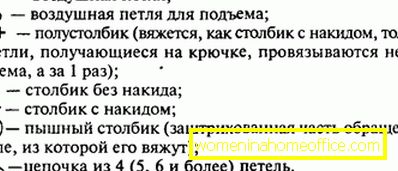Circuit conventions when knitting. abbreviations
Knitting involves a certain sequence of actions. Often each step is described in words. In other cases, in addition to the description of the knitting attached scheme. Do not be afraid of conventions and diagrams. Knitting on them is quite easy and much more convenient than a verbal description.

Schemes for knitting there for a long time. They were painted in antiquity. They are made to save time and a clear explanation of how to knit a particular pattern. Interestingly, in the West, craftswomen prefer descriptions with words. In this way there is a significant disadvantage. If the item is large with a complex pattern, the description may take many pages. It is easy to get confused and stray. Very often you can find the scheme is not the whole product, and the individual patterns. All other actions are written in the instructions in words.
Designations of schemes on schemes
Reading patterns and knitting always start from the bottom right row. The scheme is a rectangle. It is divided into small cells. Each denotes a separate loop. Inside the cage is a certain icon. The diagram is always read from the bottom up. Knitting can be repeated once. Sometimes it happens that in the verbal description indicate how many times it is necessary to repeat certain rows or all the rows completely.
Legend in knitting: abbreviations
Different schemes use different designations and abbreviations. They may not always coincide. Despite this, the same descriptions may appear in western descriptions. They look like abbreviations of English letters or letter combinations.
- P - purl loops
- K - facial
- m1- add one more loop
- RS - right side
- LS - left side
- St - stocking
- k2tog - knit two loops together
- ws - wrong side
Needle loop designations

It is easy to read the knitting pattern. Usually in any magazine besides the verbal description and the scheme there is a designation of loops. Usually it is located near the scheme. All kinds of loops are represented graphically. The icons correspond to what is shown in the diagram. In addition to the icons in the description there is a decoding. All badges are selected by magazines in such a way that they vaguely resemble the option of knitting. It happens that they are visually similar to the loop. So very often the front loop is denoted by an empty square. The purl can be represented by a dot.
In order to start knitting according to the scheme, you need to do the following:
Carefully review the picture and determine whether it shows all the rows or only the front. Examine the pattern. Remember replay location - rapports.
Next you need to refer to the description of the loops. During knitting, it is worth looking at the pattern, at the description of looping and then knitting. The designations of the loops with knitting needles are usually intuitive. It happens that it is quickly remembered, and it is no longer necessary to contact it.
Designations of patterns on the scheme
Often on the scheme depict either all knitting, or part of the pattern. This is done to simplify the work. It is easy enough to understand what is in front of you. On the description of all knitting in the form of a scheme the series are presented. They can all be depicted in full, facial and purl. Only facial can be printed. This is easily identified by row numbering. If the scheme near the rows are odd numbers (1, 3, 5, etc.), then described knitting in the front rows. In this case, purl rows knit according to the scheme: each loop - according to the picture. If the rows in the scheme are numbered in ascending order (1, 2, 3, 4, etc.), then all the rows are knitted strictly according to the scheme. In this case, the scheme is decoded as follows. The face knit from right to left, and the reverse vice versa, from left to right. Often the facial numbers are numbered on the right and the purl rows on the left. It helps to quickly understand which direction to knit.

Patterns are easy to identify. In some cases, the pattern is repeated. The term rapport is introduced into the description. In the diagram, it may be indicated by a square inverted bracket and the word "rapport". In other schemes, it is denoted by vertical lines. Between them is a part that needs to be repeated while knitting.
There is nothing easier to learn to understand knitting patterns. They are quite understandable. All loops are represented graphically, occupying a single cell in the diagram. Therefore, before starting knitting, you need to look at their designations and repeat the knitting of individual loops on the patterns. All schemes are on the same principle: knitting from right to left and top to bottom.